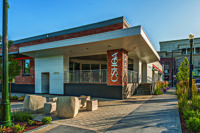Denver International Airport’s Hotel and Transit Center project has earned LEED Platinum status. The designation makes the Westin DIA the highest LEED-rated hotel at any major U.S. airport, and one of fewer than 50 LEED-Platinum buildings in Colorado. The Westin DIA is part of a project that includes three key elements: a 519-room Westin hotel and conference center; an 82,000-sq-ft, open-air plaza; and a public transit center that connects commuter rail and buses to the airport.
The glass-and-steel structure is located at the south end of Jeppesen Terminal. The building features 433,000 sq ft of hotel and conference space and offers 519 guest rooms, 35 suites and a 37,500-sq-ft conference center.
The project offers amenities to residents as well. The open-air plaza is designed to host activities and community events. Among the possibilities: farmers markets, concerts and even small sporting events, all of them designed to draw people, including people who live in the area, out to the airport.
The plaza connects the hotel and transit center to the terminal and is defined by two diagrid steel-and-glass canopies that provide travelers a covered path from trains to the security checkpoints. The canopies are structurally independent of the hotel and cantilever 135 ft over the plaza.
The hotel sits atop the airport’s integrated transit center, which offers direct commuter rail connectivity to downtown Denver as well as bus rapid transit to the surrounding Denver suburbs. Trains travel from the airport to Denver Union Station in 37 minutes via 23 miles of electric commuter rail. The trains are heavier and faster than light rail cars, with a top speed of 79 mph versus 55 mph. The new line is part of the Regional Transportation District’s Eagle P3 project, the nation’s first full public-private partnership for transit.
Energy-Saving Measures
The Hotel and Transit Center was designed to reduce energy costs by nearly 49%, reduce total energy use by approximately 43% and use 30% less water than conventional designs.
These energy savings were accomplished by incorporating design elements to increase the efficiency of the building, installing high-efficiency mechanical systems and taking advantage of daylighting via wall-to-wall windows in rooms and a panoramic, three-story-tall glass wall in the hotel’s conference area.
Other sustainable design features of the Hotel and Transit Center include:
- Landscaping that uses native or adapted plant species with low water requirements
- Low-flow showerheads and dual-flush toilets
- Demand-control ventilation in spaces with varying occupancy levels such as conference rooms and common areas
- Sustainable maintenance and facilities operations practices
- A sophisticated energy management and control system provides the facility operations team unprecedented insight into real-time building performance and operations
- Reduced landfill waste by diverting and recycling more than 65% of construction debris
- Nearly 15% of materials (predominantly concrete and steel) were sourced from within 500 miles, reducing the pollution associated with shipping
- Recycling bins are provided in public areas, guest rooms and office spaces to encourage recycling of waste generated by the building’s employees, guests and visitors
- About 17% of recycled materials were used in the project in the form of steel, fly ash (a component of concrete that is a byproduct of local coal-fired power plants), carpet, insulation, tile and more
- Room keycards enable activation of guest-room plug loads, lighting and manual temperature controls
- About 81% of the total wood-based building materials are certified in accordance with the principles and criteria of the Forest Stewardship Council
- Automatic temperature setbacks are enabled when rooms are unoccupied
- Indoor ceiling and floor heights were optimized with the glazing selection to maximize daylight penetration into the building, while reducing glare and solar heat gain
- Escalators incorporate load-shedding controls to reduce energy use when passenger load decreases
- High-performance lighting systems deliver exceptional light quality and quantity for both general illumination and highlight lighting, while integrating with daylight harvesting controls.


